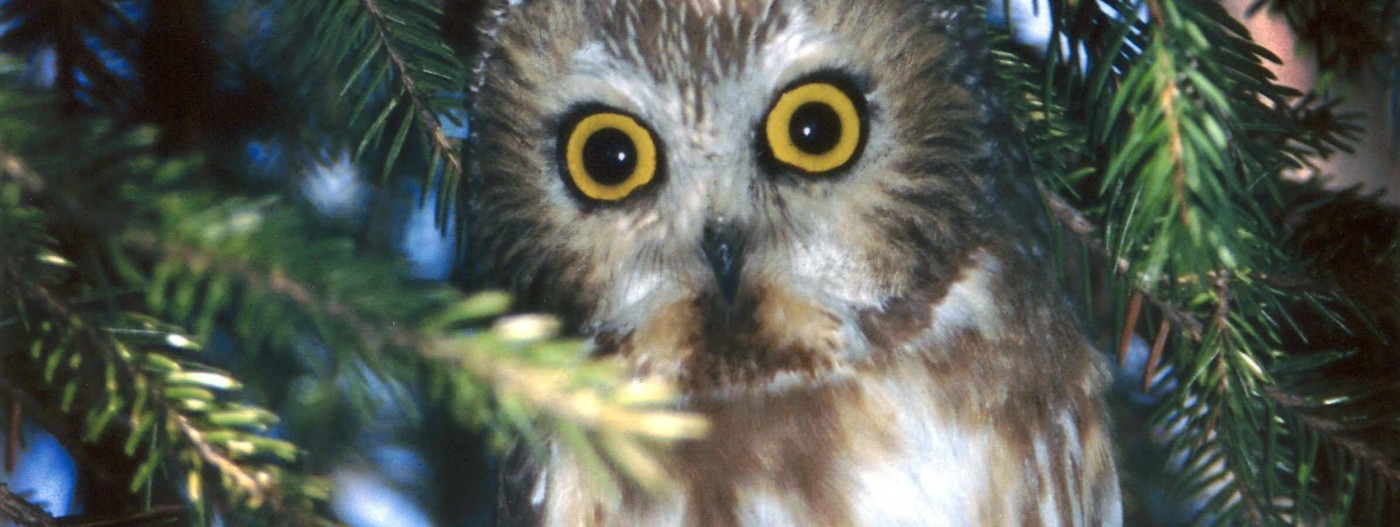Animals and Plants of the Finger Lakes
Saw-Whet Owls Sound Off
One cold, still evening in winter some years ago, as I was closing up the hen house, a soft, repetitive tooting came down from the wooded hillside.
I might easily have failed to notice it, if field guides had not prepared me; now I recognized in this faintly audible disturbance the distant voice of the littlest owl in eastern North America, the Northern Saw-whet Owl.
Nightly thereafter I whistled the simple call, hoping for a look at the three-ounce raptor. My imitations were thin, but owls have excellent hearing: excited respondents soon appeared on nearby branches, or swooped very close, their shadows darting over the moonlit snow. A really satisfying view eluded me, though, until the following winter, when a Saw-whet flew in to perch on a sumac twig within arm’s reach, tooting quizzically in the last glow from the western sky.

In time it became clear that Saw-whet Owls wintered annually here. Concealing themselves in dense conifers by day, active only at night, these pint-sized mousers are normally silent except at the onset of breeding season, and probably go undetected in many locations. The unusual midwinter calling that attracted my attention subsided after several years, but my whistle still elicits responses, and moonlight often reveals a curious little owl whose noiseless flight conveys nothing at all to my ears.
Saw-whet Owls breed from southern Alaska to Nova Scotia, hence the scientific name Aegolius acadicus, the ‘Acadian owl’. Breeding extends southward in the Appalachians to the Great Smoky Mountains. Typical habitat is fairly mature coniferous or mixed forest with openings, often near water. Nesting birds are quiet, and their nest-holes are seldom discovered. Some Saw-whets reside year-round in breeding areas; others engage in seasonal movements of an unclear nature. In New York, many Saw-whets are found each spring and fall roosting in conifer groves along the shores of Lake Ontario and Long Island.
Between 1980 and 1985, volunteers surveying for the first Atlas of Breeding Birds in New York State found Saw-whets chiefly in the Adirondacks. In the Finger Lakes region, reports of possible or probable breeding were scarce, and breeding was confirmed in just one location. Fieldwork for the second atlas, which began in 2000, promises to augment our picture of the regional breeding distribution of this very inconspicuous species.
In my neighborhood, a lush coniferous swamp amply furnished with appropriable woodpecker holes offered possible breeding habitat for Saw-whet Owls. One bright July afternoon in my third year of wading there, preoccupied with Brown Creepers, Northern Waterthrushes and other swamp birds, I ducked into a shrub-willow thicket and came face-to-face with Saw-whet fledglings, for an unforgettably close look at a bird that had captivated me since that winter evening by the hen house years earlier.
Nocturnal birds exert a compelling fascination over the susceptible. Unobtrusive to the point of inscrutability, the little Saw-whet Owl worked on my imagination like a remembered view of the night sky through a large telescope, intensifying awareness of the depth of nature, in which so many things pass unobserved. Friends say I’m very lucky to have Saw-whets return year after year, but on reflection it seems likely they were here long before I knew it. The luck may lie less in their continuing presence than in the way I came to be informed of it.
This story by Geo Kloppel first appeared in our newsletter, The Land Steward, as part of the Closer Look series about plants and animals of the Finger Lakes region.





